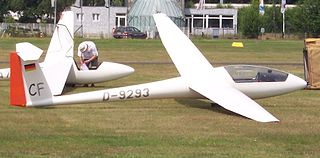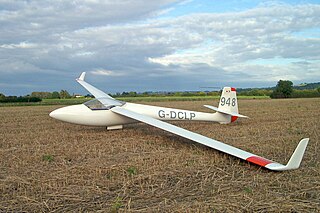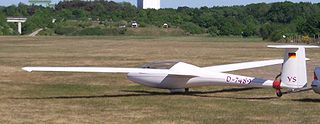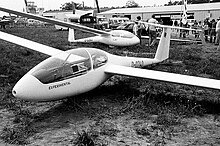
The Schempp-Hirth Discus is a Standard Class glider designed by Schempp-Hirth. It was produced in Germany between 1984 and 1995 but has continued in production in the Czech Republic. It replaced the Standard Cirrus. It was designed by Klaus Holighaus.

The Rolladen-Schneider LS6 is a 15 metre and 18 metre single-seat flapped glider manufactured by Rolladen-Schneider Flugzeugbau GmbH between 1984 and 2003.

The Rolladen-Schneider LS7 is a high-performance Standard Class single-seat sailplane produced by Rolladen-Schneider Flugzeugbau GmbH from 1988 to 1993.

The Rolladen-Schneider LS3 is a 15 metre single-seat glider produced by Rolladen-Schneider from 1976 to 1983.

The LS11 or AFK1 is a prototype Two-Seater Class sailplane currently in development at Akaflieg Köln e.V.. The LS11 first flew on 5 November 2005.

The Rolladen-Schneider LS4 is a Standard Class single seat glider manufactured by Rolladen-Schneider Flugzeugbau GmbH between 1980 and 2003.

The Rolladen-Schneider LS2 is a 15-metre span single seat glider prototype with trailing-edge flaps, designed and built by Rolladen-Schneider Flugzeugbau GmbH c. 1973.

The Schempp-Hirth Mini Nimbus is a 15 Metre-class glider designed and built by Schempp-Hirth GmbH in the late 1970s.

The Rolladen-Schneider LS1 is a Standard Class single-seat glider manufactured in Germany by Rolladen-Schneider from 1968 to 1977.

The Rolladen-Schneider LS8 is a Standard and 18 metre class single-seat glider developed by Rolladen-Schneider and in series production since 1995. Currently it is manufactured by DG Flugzeugbau.

The Rolladen-Schneider LS9 is an 18 metre single-seat motor glider launched in 2000 by Rolladen-Schneider. Production ended after just 10 gliders were built, when Rolladen-Schneider went into receivership.

The ASW 28 is a Standard Class glider with a fifteen-metre span built of modern fibre reinforced composites. The manufacturer of the ASW-28 is Alexander Schleicher GmbH & Co. The 'W' indicates this is a design of the influential and prolific German designer Gerhard Waibel. Serial production started in 2000.
The Rolladen-Schneider LS10 is an 18 metre sailplane designed in Germany by Rolladen-Schneider. A prototype flew in 2003.

The Glasflügel 201 Standard Libelle is an early composite Standard Class single-seat sailplane produced by Glasflügel from 1967.

HpH 304 is a family of sailplanes ranging from a single-seat composite 15 metre Class to a two-place 20 metre Open Class manufactured by the Czech company HpH Ltd. The sailplane was derived from a glider made by Glasflügel between 1980 and 1982 that was put back in production by HpH and who have modified it substantially and developed new models since.

The Glasflügel 303 Mosquito is a composite 15 metre Class single-seat sailplane manufactured by Glasflügel between 1976 and 1980.

The Schneider ES-65 Platypus is a two-seater unflapped glider designed and built by Edmund Schneider Pty in Australia. A single prototype was built, which remains operational as of 2012.

The ASW 19 is a single-seat glider built by Alexander Schleicher GmbH & Co, first flying in 1975. It was originally designed as a Standard Class glider, but now mainly competes in the Club Class. The ASW 19 is known for its pleasant handling and some clubs use it as a training glider. It was succeeded by the all-new Schleicher ASW 24.

The SZD-56 Diana is a 15 metre Class glider originally designed by Bogumił Bereś at PZL-Bielsko. However, PZL Bielsko went bankrupt before it could be put into serial production.

The SZD-41 Jantar Standard was a Standard Class glider designed and produced in Poland from 1973.




















